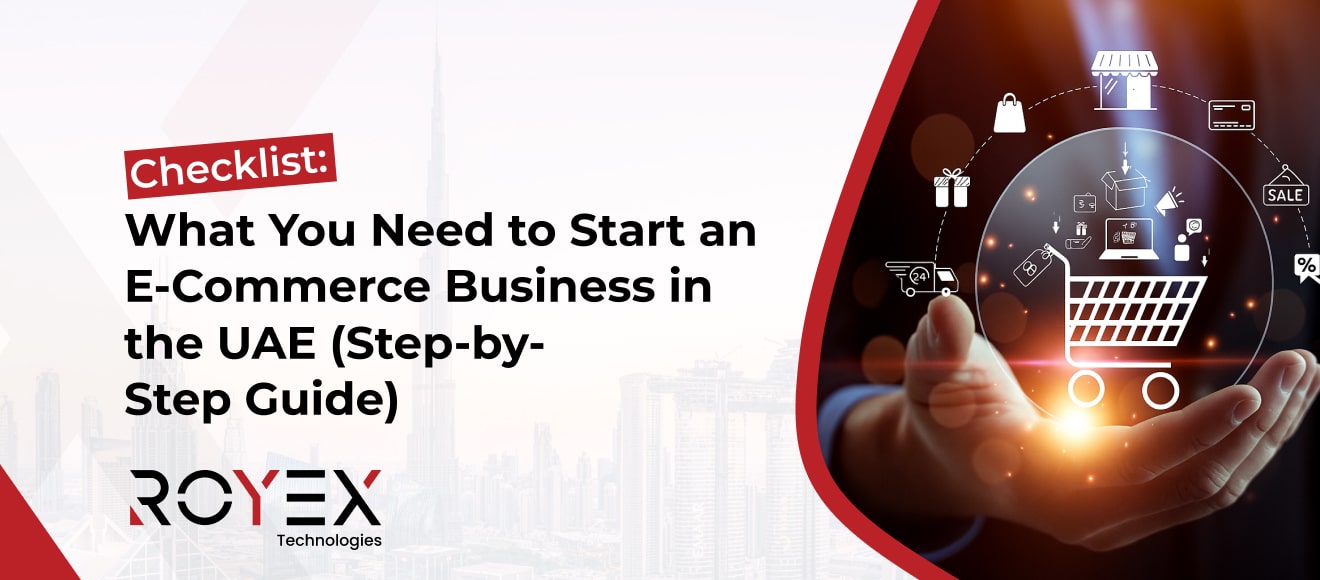
Checklist: What You Need to Start an E-Commerce Business in the UAE (Step-by-Step Guide)
The United Arab Emirates (UAE) is quickly emerging as a global e-commerce hub. In 2024, the UAE e-commerce market was valued at AED 32.3 billion (USD 8.8 billion) and is projected to exceed AED 50.6 billion (USD 13.8 billion) by 2029, demonstrating a compound annual growth rate (CAGR) of approximately 21.4%.
This rapid growth is fueled by high internet penetration, smartphone adoption, and a population that increasingly prefers online shopping.
Yet, while opportunities abound, starting an e-commerce business in the UAE comes with unique challenges. The competitive landscape, regulatory framework, logistics infrastructure, and digital consumer behavior require careful planning and informed decision-making.
This comprehensive checklist offers a step-by-step guide for entrepreneurs and business owners aiming to establish a successful e-commerce venture in the UAE. By combining market insights, actionable strategies, and UAE-specific data, this guide provides everything you need to know to build, operate, and scale your online store successfully.
1. Understand the UAE E-Commerce Market
Market Size and Growth
The UAE’s e-commerce market has seen exponential growth over the last decade. As of 2024:
-
Market Value: AED 32.3 billion (~USD 8.8 billion)
-
Projected Market Value by 2029: AED 50.6 billion (~USD 13.8 billion)
-
Annual Growth Rate: 21.4% CAGR
Consumer confidence in online shopping has grown, driven by a tech-savvy population, robust logistics infrastructure, and widespread digital payment adoption.
Consumer Demographics
Key characteristics of the UAE online shopper:
-
Age Groups: 18–44 years account for the majority of online purchases.
-
Mobile Shopping: 72% of e-commerce transactions are conducted via smartphones.
-
Preferred Categories: Fashion, electronics, beauty, groceries, and home appliances dominate sales.
Understanding these demographics ensures your e-commerce business is tailored to the preferences and behaviors of UAE consumers.
Market Opportunities and Challenges
-
Opportunities: The UAE has high disposable income, an appetite for global brands, and fast adoption of new technologies.
-
Challenges: Competition is fierce, and consumer expectations are high for delivery speed, payment flexibility, and customer service.
A strong understanding of the market is the foundation for a successful e-commerce venture.
2. Choose the Right Business Model
The foundation of your e-commerce venture is the business model. Choosing the right model impacts your operations, revenue streams, and long-term scalability.
Common Models
-
Business-to-Consumer (B2C): The most popular in the UAE. Selling directly to consumers via online stores.
Pros: Direct customer relationships, higher margins.
Cons: Requires extensive marketing and customer acquisition efforts. -
Business-to-Business (B2B): Selling products or services to other businesses.
Pros: Larger transaction values, long-term contracts.
Cons: Sales cycles are longer, marketing requires specialized channels. -
Consumer-to-Consumer (C2C): Platforms like Dubizzle or social media marketplaces.
Pros: Low overhead, peer-to-peer transactions.
Cons: Revenue depends on transaction fees, less control over quality.
Hybrid and Subscription Models
-
Hybrid: Combining B2C and B2B allows diversification. For instance, selling to both retail customers and wholesale buyers.
-
Subscription-Based: Ideal for products with recurring demand, such as groceries or personal care items. Subscription models improve cash flow predictability.
Selecting a model requires aligning with your target market, logistics capabilities, and revenue goals.
3. Register Your Business and Obtain Licenses
Compliance with UAE regulations is non-negotiable. Legal registration ensures credibility and avoids penalties.
Free Zone vs. Mainland
-
Free Zone:
-
Full foreign ownership
-
Tax incentives
-
Restrictions on direct trading with UAE residents outside the free zone
-
-
Mainland:
-
Ability to trade directly with UAE consumers
-
Requires local sponsorship or partner (unless 100% foreign ownership applies to certain sectors)
-
Choosing the right jurisdiction impacts operations, taxation, and growth potential.
E-Commerce License
An e-commerce license is mandatory and is issued by:
-
Department of Economic Development (DED) for mainland businesses
-
Free Zone Authorities like DMCC, Dubai CommerCity, or Sharjah Media City
This license allows your business to operate online legally and facilitates partnerships with payment gateways and couriers.
VAT Registration
If your turnover exceeds AED 375,000 annually, VAT registration with the Federal Tax Authority (FTA) is required.
-
Standard VAT rate: 5%
-
Compliance ensures legitimacy and trust with customers.
4. Choose the Right E-Commerce Platform
Selecting the correct platform is crucial for scalability, performance, and customer experience.
Popular Options in UAE
-
Shopify: User-friendly, quick setup, ideal for small to medium stores.
-
Magento: Powerful for large-scale operations, customizable, requires technical expertise.
-
WooCommerce: WordPress-based, flexible, suitable for content-heavy stores.
-
Custom Solutions: Tailor-made for unique business needs, higher upfront cost but scalable long-term.
Features to Consider
-
Mobile optimization
-
Multi-language support (Arabic + English)
-
Integration with UAE payment gateways (PayFort, Telr, PayPal, etc.)
-
Scalability for future growth
-
Built-in analytics for insights
Platform choice affects operational efficiency, cost, and the overall customer experience.
5. Develop a User-Centered Website
A strong website design is crucial for conversions.
UX and UI Best Practices
-
Navigation: Simple menus, search bars, and filters.
-
Loading Speed: Websites should load under 3 seconds to reduce bounce rates.
-
Checkout Process: Minimize steps, support guest checkout, and multiple payment options.
-
Security: Implement SSL certificates, PCI DSS-compliant payment gateways.
Mobile Optimization
With 72% of UAE consumers shopping via mobile devices, responsive design and mobile-first layouts are mandatory.
Content and Product Pages
-
High-quality images and videos
-
Clear descriptions with specifications, sizes, and warranty information
-
Customer reviews and ratings to build trust
A well-optimized website reduces cart abandonment and increases conversions.
6. Implement Diverse Payment Solutions
Payment flexibility is critical in UAE e-commerce.
Popular Options
-
Credit/debit cards
-
Digital wallets: Apple Pay, Google Pay, Payit
-
Cash on delivery (COD) – still popular for 30–40% of first-time shoppers
-
Bank transfers for B2B or high-value purchases
Security Measures
-
PCI-DSS compliance
-
Two-factor authentication
-
Anti-fraud systems
Offering multiple secure payment options reduces friction and builds customer confidence.
7. Plan Logistics and Inventory Management
Efficient logistics are a competitive differentiator.
Shipping Partners
-
Aramex, Fetchr, DHL, and local couriers offer different pricing, speed, and coverage.
-
Evaluate based on: cost, reliability, and fulfillment time.
Delivery Options
-
Same-day delivery in Dubai and Abu Dhabi
-
Next-day delivery for national coverage
-
Scheduled delivery for convenience
Inventory Management
-
Real-time tracking of stock
-
Automated notifications for low stock
-
Integration with website to prevent overselling
Good logistics and inventory planning improve customer satisfaction and reduce operational costs.
8. Develop a Digital Marketing Strategy
Digital marketing drives traffic, brand awareness, and sales.
SEO
-
Optimize website for Arabic and English keywords
-
Focus on long-tail search terms for UAE-specific queries
-
Local SEO for location-based searches
Social Media Marketing
-
Instagram, TikTok, and Facebook are key platforms
-
Influencer partnerships to boost brand credibility
-
Paid ads for targeted campaigns
Email Marketing
-
Personalized offers and reminders
-
Loyalty program updates
-
Abandoned cart recovery
Content Marketing
-
Blogs, guides, and product tutorials
-
Arabic and English content for broader reach
-
Build authority and improve organic traffic
9. Focus on Customer Experience and Retention
Customer service drives repeat purchases.
Support Channels
-
Live chat, WhatsApp, email, and call centers
-
AI chatbots for 24/7 support
Policies
-
Clear return and refund guidelines
-
Warranty and guarantee information
-
Flexible shipping and payment options
Loyalty Programs
-
Reward points
-
Exclusive offers for repeat customers
-
Referral programs
High-quality customer experience increases lifetime value (LTV) and reduces churn.
10. Monitor Analytics and Optimize Performance
Key Metrics
-
Conversion rate
-
Average order value (AOV)
-
Customer acquisition cost (CAC)
-
Return on ad spend (ROAS)
-
Cart abandonment rate
Tools
-
Google Analytics
-
Hotjar (for UX insights)
-
Social media analytics dashboards
Continuous monitoring and A/B testing refine marketing and operational strategies.
11. Legal and Regulatory Compliance
Data Protection
-
UAE’s data privacy laws require secure storage of customer information
-
Compliance with GDPR for international customers
Consumer Protection
-
Accurate product descriptions
-
Transparent pricing
-
Refund and warranty compliance
E-Commerce Regulations
-
Regularly check updates from DED, UAE TRA, and Free Zone Authorities
Compliance mitigates risk and enhances credibility.
12. ROI Planning and Financial Forecasting
Cost Breakdown
-
Platform development: AED 20,000–100,000
-
Marketing: 10–20% of revenue
-
Logistics: 5–10% of revenue
-
Payment gateway fees: 2–3% per transaction
Expected ROI
-
Break-even: 6–12 months for small-medium businesses
-
Profitable revenue targets: AED 500,000+ per year for SMBs, AED 1M+ for larger ventures
Budgeting Tips
-
Start lean; expand marketing spend after early traction
-
Monitor customer acquisition cost (CAC) vs. lifetime value (LTV)
13. Scaling Your E-Commerce Business
-
Expand product lines based on customer demand
-
Explore cross-border e-commerce in GCC and MENA
-
Invest in automation for inventory, marketing, and support
-
Analyze KPIs for strategic expansion
Scaling requires both operational readiness and financial planning.
Why Choose Royex Technologies for E-Commerce Development
Royex Technologies is a trusted partner for UAE e-commerce businesses, offering:
Expertise
-
Over 12 years of experience in web and mobile solutions
-
500+ projects delivered, including 120+ e-commerce stores
Tailored Solutions
-
Customizable platforms aligned with brand vision
-
Integration with UAE-specific payment gateways and logistics providers
Full-Service Capabilities
-
Design, development, digital marketing, and maintenance
-
UX optimization for mobile-first UAE shoppers
Proven Results
-
Clients achieve higher conversion rates, faster ROI, and scalable operations
-
Success stories include fashion, electronics, and FMCG e-commerce stores
Choosing Royex ensures your e-commerce venture is technically robust, market-ready, and scalable for long-term success. Established in 2013, Royex Technologies is a leading E-Commerce Web Design Company in Dubai that provides innovative solutions for small, medium, and large-scale companies. We specialize in responsive web development, mobile app development, CRM integration, AI solutions for website & mobile applications, and many more. Our extensive experience in mobile app development will help you to take your business to a high level.
Conclusion
Launching an e-commerce business in the UAE is a high-potential but complex endeavor. From legal registration to UX design, payment systems, logistics, marketing, and scaling strategies, every step requires meticulous planning.
By following this step-by-step checklist and leveraging the expertise of a seasoned development partner like Royex Technologies, entrepreneurs can navigate the competitive UAE digital marketplace with confidence, maximize ROI, and build a thriving online store.
Your roadmap to e-commerce success in the UAE starts here.





